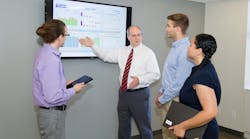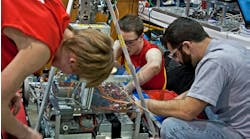In his 30 years in IT, Sherwin-Williams CIO Tom Lucas has seen his profession come up from a “dark room in the basement” into daylight. Instead of programming in solitude all day, IT professionals nowadays "have to understand how a plant works, how a distribution center works, and what our customers really want when they come in to buy paint from our paint stores,” he says. They have to teach drivers on paint trucks how to fix problems with their GPS and work with marketing people to convey technical instructions in language that actual humans use.
When Lucas took his current post in 2000, the Cleveland-based paint and coatings company didn’t have much of a pipeline to develop IT talent. There were a few summer internships, but they had limited appeal. “By the time a student gets in and figures out the building and the tools, you’ve burned through most of the summer and their ability to contribute is limited,” Lucas explains.
Tapping into apprenticeship know-how he’d gained from other jobs, Lucas set about establishing a Professional Apprenticeship program that consisted of at least a year paid, on-the-job training for IT students at local two and four-year colleges. The program immerses them in company culture and gives them plenty of real-world experience.
To rustle up some recruits, he and his team cold-called college placement offices and arranged meetings with professors whom, they’d heard, liked the idea of internships.
He found he had to educate the educators on collaborating. “The colleges were not used to companies reaching out directly to them,” Lucas says. “Today it is so much easier. You call the schools and ask for the placement office and they all are pretty attuned with onboarding companies into their process for internships.”
About 30 students were in the first PA class. “I had a series of goals,” says Lucas. “One was to have an effective pipeline of talent. I wanted to minimize recruiting fees and effort, and I wanted to minimize turnover. ” He also wanted to build more internal leaders, who learned by mentoring the students, and encourage “an influx of wild ideas and new thinking” from the real and academic worlds.
The PA program has since grown to 84 students, who work from 15 to 28 hours per week while they attend school. They are paid $15 an hour, serve from one to three years and receive some of the benefits of regular employees—matching 401K, use of the company’s workout facility, and admission to company networking functions. If they get hired full-time after graduation, their apprenticeship work counts toward vacation time and years of service.
PAs go through three orientations—an HR orientation like any other employee, an IT-specific orientation and, after their first day, a department orientation. Lucas also meets one-on-one with every hire three or four weeks into the apprenticeship.
'Born Out of Desperation'
The PA program was the culmination of about 15 years of studying apprenticeships and trial-and-error at Lucas’ own workplaces.
Early in his career, he hired computer-savvy high school students to configure PCs at Marquip, the industrial machinery plant where he was IT director. “It was born out of desperation and needing help,” he says.
During work travels, he saw German apprenticeship programs in action, and was impressed by how students developed their expertise on the job, with the oversight of instructors and more experienced co-workers.
In the 1990s, while working as IT director of a materials handling company, Lucas took a post on the advisory board of the University of Milwaukee. Facing budget cuts, the university’s CIO had turned his full-time staff into advisors and hired 200 part-time students to do the hands-on IT work. “It gave me a lot of insight,” Lucas said. “That with the right guidance, students could do amazing things.”
“You can’t just bring a person in and have them file papers,” he adds. “They need a mentor, someone in their domain area who can coach and guide them on a regular basis. They need to be challenged right away. This is your next generation of workers here. Make the commitment—push them just like you do your regular workers.”
Daniella Pomales, a single mom in her 30s who attends Cleveland State University, developed an interest in information security while working at the help desk in the city of Cleveland’s IT department. As a PA Sherwin-Williams, she’s on the network security side, “so I’ve gotten to see how issues are troubleshooted. If somebody believes their emails have been hacked or corroborated, we go and investigate and ask questions.”
Pomales also has an associate’s degree in art, a background she mined recently to create a diagram that cleared up a lot of confusion. Her handiwork explained a routing problem that “one of our more technical guys was able to figure out” but everyone else had trouble understanding.
She worked with the techie to explain things visually. “A lot of people are kind of intimidated by this guy because he is so smart, but I like that and I’m up for the challenge,” she says.
Lucas views the PA program as an “extended interview” for both the students and the company. After two or three years of immersion, there are few unknowns: The apprentice can navigate the company’s culture, and supervisors know they’ve helped mold an employee with both the technical chops and the soft skills to succeed.
The PAs make up about 9% of Sherwin’s total IT workforce. “Some of the smaller projects, it’s like eh, I don’t’ know if I want to take a full-time person who’s making a lot of money and have them work on it,” says Lucas. “We can give those good projects to the students to work on, and our net costs go down.
It also frees up expert employees for more challenging projects. “If you’re a network engineer, there’s a body of your time that’s [focused on work] that’s important but not highly technical,” says Lucas. “I could take a full-time person and give 20% of their role to the student. The student wins because they’re gaining really valuable useful skills. The employee wins because I’m taking some of that lower level stuff out.”
Getting Under the Hood
One of the rare PAs without an IT background, Cleveland State marketing student Marissa Berardinelli works with corporate IT people on developing internal communications—blog posts, videos, emails—that non-techies can understand. Her main project is promoting adoption of My IT, the company’s new internal help desk program.
Having different backgrounds encourages cross-pollination, she says. “The team that I work with, they have made attempts to try and communicate [on their own] what they have to offer and how it works, but it doesn’t always come out in the most layman’s-terms-type way.”
David Diemert, a PA who attends Cuyahoga Community College, arrived at Sherwin-Williams in 2015. Since then, he’s helped set up a disaster data recovery center at the company’s automotive paints research center and worked on a program that halved the time to fix truck drivers’ phones. A deskside support person, he loves “being able to remote in and get under the hood of the device” and figuring out the fastest way of solving a problem.
“To be trusted with such expensive equipment, and I’m not even a full-timer yet—it’s a much better experience than other places where you’re micromanaged,” says Diemert. “My managers are really trusting me, which makes me want to be a better worker, too.”
Not all PAs are hired after graduation—there are substantially more apprenticeships than there are open positions. The company’s IT department has a 4% annual turnover rate, and one in four of its permanent IT employees are women.
“I’ve had some people cry—‘I can’t believe I can’t get a job here,’” says Lucas. “They don’t want to leave. But they keep up with us and a few years later when we do have an opening, sometimes they’ll come back--and they’ve gone out and gotten even more skills.”





